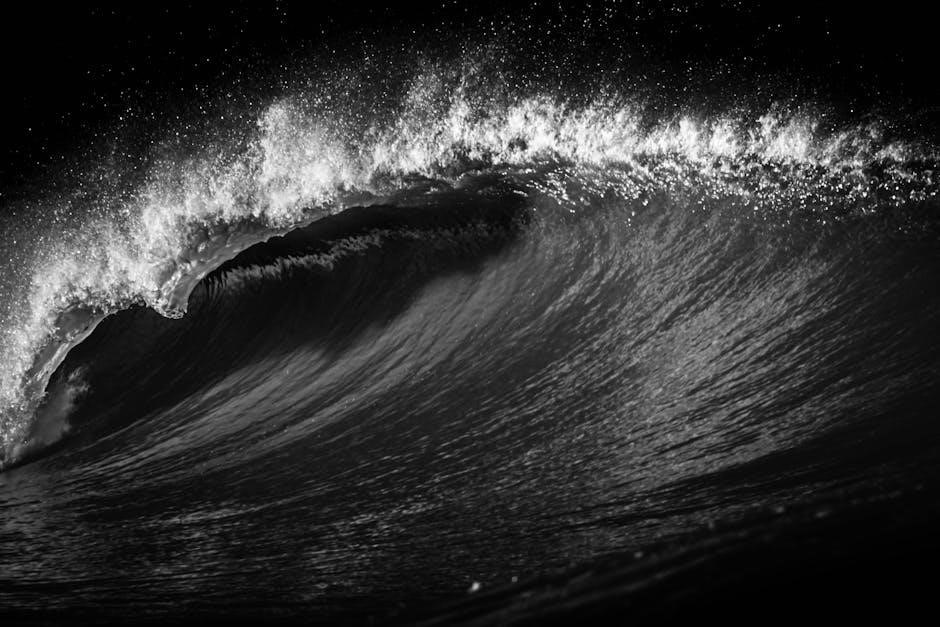
canon 7d mark ii instruction manual
The Canon EOS 7D Mark II is a high-performance DSLR camera designed for enthusiasts and professionals. Featuring a 20.2MP APS-C CMOS sensor and dual DIGIC 6 processors, it delivers exceptional image quality and fast processing. With advanced autofocus, 10fps continuous shooting, and robust video capabilities, it’s ideal for capturing dynamic subjects and creative projects. The instruction manual is essential for mastering its extensive features and settings, ensuring users unlock the camera’s full potential.
Overview of the Camera and Its Features
The Canon EOS 7D Mark II is a powerful DSLR camera designed for enthusiasts and professionals, offering a 20.2MP APS-C CMOS sensor, dual DIGIC 6 processors, and 10fps continuous shooting. It features a 65-point all-cross-type AF system, weather-sealed construction, and advanced video capabilities. The camera’s robust design and ergonomic controls make it ideal for capturing high-quality images in various conditions, with the instruction manual providing detailed guidance to optimize its features.
Importance of the Instruction Manual
The instruction manual is a comprehensive guide to understanding and utilizing the Canon EOS 7D Mark II’s advanced features. It provides detailed explanations of camera settings, troubleshooting tips, and maintenance advice. The manual also includes information on firmware updates, ensuring users can optimize their camera’s performance and explore its full capabilities effectively.
Key Features of the Canon EOS 7D Mark II
The Canon EOS 7D Mark II features a 20.2MP APS-C CMOS sensor, dual DIGIC 6 processors, 10fps continuous shooting, and a 65-point cross-type AF system, ensuring exceptional performance.
20.2 Megapixel APS-C CMOS Sensor
The Canon EOS 7D Mark II is equipped with a 20.2-megapixel APS-C CMOS sensor, delivering high-resolution images with excellent detail and color accuracy. Its advanced sensor design captures a wide dynamic range, ensuring vibrant colors and reduced noise, making it ideal for both still photography and video recording.
Dual DIGIC 6 Image Processors
The Canon EOS 7D Mark II features dual DIGIC 6 image processors, enhancing performance by enabling faster image processing, improved noise reduction, and advanced autofocus capabilities. These processors ensure high-speed continuous shooting, accurate color reproduction, and efficient handling of large image files, making the camera highly responsive for both stills and video.
10 fps Continuous Shooting
The Canon EOS 7D Mark II delivers an impressive 10 frames per second continuous shooting capability, ideal for capturing fast-moving subjects. Dual DIGIC 6 processors enable rapid image processing, ensuring sharp, high-quality images. This feature is particularly beneficial for sports, wildlife, and action photography, allowing photographers to freeze fleeting moments with precision and clarity.
65-Point All Cross-Type AF System
The EOS 7D Mark II’s 65-Point All Cross-Type AF system ensures precise and rapid autofocus performance. Cross-type sensors enhance accuracy, while the extensive 65-point coverage provides flexible subject tracking. This advanced system excels in dynamic situations, making it ideal for capturing sharp images of moving subjects, even in challenging lighting conditions, with exceptional reliability.

Getting Started with the Canon EOS 7D Mark II
Unbox and set up your camera, charge the battery, and insert memory cards. Familiarize yourself with basic controls and layout to begin capturing stunning images effortlessly.
Unboxing and Initial Setup
Unbox your Canon EOS 7D Mark II, ensuring all accessories like the battery, charger, and neck strap are included. Handle the camera with care to avoid damage. Charge the battery fully (about 2 hours) until the charge lamp turns green. Insert the battery into the camera, power it on, and follow the on-screen prompts to set language, date, time, and other initial preferences. Refer to the manual for detailed setup guidance.
Charging the Battery and Using Memory Cards
Charge the LP-E6N battery using the provided LC-E6 charger until the lamp turns green (about 2 hours). Use high-speed memory cards (U3 or higher) for optimal performance. Insert the battery into the camera and format new memory cards via the menu to ensure compatibility and prevent data issues. Always use a card reader for safe image transfers.
Basic Camera Controls and Layout
Familiarize yourself with the mode dial, shutter button, and control layout. The quick control dial and multi-controller enable easy adjustments. Key buttons include ISO, AF-ON, and white balance. The LCD screen and optical viewfinder provide essential previews and settings. Understand the placement of ports and memory card slots for seamless operation and customization of your shooting experience.

Understanding the Camera Controls
Mastering the mode dial, customizable buttons, and multi-controller enhances shooting efficiency. The menu system provides detailed settings for personalization, ensuring intuitive control over advanced features and functions.
Mode Dial and Shooting Modes
The mode dial offers various shooting modes, including Manual (M), Aperture Priority (Av), Shutter Priority (Tv), and Auto modes. These settings cater to different photography needs, allowing users to control exposure elements like aperture, shutter speed, and ISO. The instruction manual details each mode’s functionality, helping users optimize their shooting experience for desired results.
Customization Options for Buttons and Dials
The Canon EOS 7D Mark II allows extensive customization of buttons and dials, enabling personalized control. Users can assign functions to buttons like the Multi-controller and rear dial, tailoring the camera to their shooting style. The instruction manual provides detailed guidance on configuring these settings to enhance shooting efficiency and comfort.
Navigating the Menu System
The Canon EOS 7D Mark II menu system is organized into tabs for easy navigation. Use the Quick Control Dial to scroll through options and select items with the Set button. The menu provides access to customize settings, adjust features, and update firmware. The instruction manual details each menu function, ensuring intuitive operation and full customization.
Shooting Modes and Settings
The Canon EOS 7D Mark II offers various shooting modes, including Manual, Aperture Priority, Shutter Priority, and Auto modes, allowing users to customize settings for optimal results. The instruction manual provides detailed explanations to help photographers master these modes and achieve creative control over their images.
Manual Mode (M)
Manual Mode (M) on the Canon EOS 7D Mark II grants full control over aperture, shutter speed, and ISO, enabling precise adjustments for creative photography. The instruction manual guides users through setting exposures manually, ensuring optimal results in various lighting conditions by balancing these elements effectively for desired artistic outcomes.
Aperture Priority Mode (Av)
Aperture Priority Mode (Av) allows users to set the desired aperture, with the camera automatically adjusting the shutter speed. This mode is ideal for controlling depth of field and achieving creative effects. The instruction manual provides detailed guidance on using Av mode effectively for various photographic scenarios and lighting conditions.
Shutter Priority Mode (Tv)
Shutter Priority Mode (Tv) lets photographers set the shutter speed, with the camera adjusting the aperture automatically. This is perfect for capturing motion effects, freezing fast-moving subjects, or creating artistic blur. The manual explains how to use Tv mode effectively for various dynamic shots and lighting conditions, ensuring optimal results every time.
Auto Modes and Scene Settings
Auto Modes and Scene Settings simplify photography by automatically adjusting camera settings for specific situations. The EOS 7D Mark II offers modes like Portrait, Landscape, and Sports, optimizing settings for ideal results. Scene settings adapt to environments, ensuring balanced exposure, ISO, and focus, making it easy to capture stunning images in various conditions effortlessly.
Focusing and Metering Systems
The EOS 7D Mark II features a 65-point all cross-type AF system for precise subject tracking and sharp focus. Its metering system uses a 150,000-pixel RGB sensor for accurate exposure and iTR for enhanced AF precision.
Understanding Autofocus Modes
The Canon EOS 7D Mark II offers One-Shot AF for stationary subjects, AI Focus AF for switching between still and moving subjects, and AI Servo AF for continuous tracking of moving subjects. The manual explains how to select and customize these modes for optimal performance in various shooting scenarios.
Configuring Metering Modes
The Canon EOS 7D Mark II offers four metering modes: Evaluative, Center-Weighted, Spot, and Partial. Evaluative provides balanced exposure, while Center-Weighted emphasizes the center. Spot metering measures a specific area, and Partial covers a larger spot. The manual guides how to select and adjust these modes for precise exposure control in various lighting conditions.
Using Focus Points and Tracking
The Canon EOS 7D Mark II features a 65-point all cross-type AF system, enabling precise focus control. Users can manually select focus points or use zone AF for dynamic tracking. The manual explains how to customize AF modes, such as AI Servo for moving subjects, ensuring sharp focus in challenging situations.
Image Quality and Customization
The Canon EOS 7D Mark II offers customizable image settings, including Picture Styles, White Balance, and noise reduction. These features allow photographers to fine-tune image quality for optimal results.
Setting Image Quality and File Formats
The Canon EOS 7D Mark II allows users to customize image quality and file formats. Choose from JPEG, RAW, or RAW+JPEG settings. RAW files provide maximum flexibility for post-processing. The camera also supports multiple image quality settings, enabling photographers to balance file size and detail based on their needs for optimal results.
White Balance and Picture Styles
The Canon EOS 7D Mark II offers customizable white balance settings to ensure accurate color representation. Users can choose from options like Auto, Daylight, and Shade, or set a custom white balance. Additionally, Picture Styles allow photographers to adjust sharpness, contrast, and color tone, enabling personalized artistic control over images directly in-camera.
Noise Reduction and Anti-Flicker
The Canon EOS 7D Mark II features advanced noise reduction settings to minimize grain in low-light conditions. The anti-flicker mode helps maintain stable exposure under flickering light sources. Both functions are customizable, allowing photographers to optimize image quality and reduce distractions, ensuring sharp and clear results in various shooting environments.

Autofocus System and Tracking
The Canon EOS 7D Mark II features an advanced 65-point all cross-type AF system for precise subject tracking. Customizable settings and AI Servo mode enhance focus accuracy, especially for moving subjects.
Configuring the AF System for Different Subjects
The Canon EOS 7D Mark II allows users to configure its 65-point AF system for various subjects. Adjust AF case studies, AF points, and tracking sensitivity via the menu system. Custom settings optimize focus accuracy for static or moving subjects, ensuring precise tracking and sharp images in diverse shooting scenarios.
Using AI Servo for Moving Subjects
AI Servo mode excels at tracking moving subjects, providing continuous focus adjustments. Enable it via the AF operation selection in the menu. Use the 65-point AF system to lock onto subjects, and customize tracking sensitivity and acceleration/deceleration settings for optimal performance. This mode is ideal for sports, wildlife, and dynamic action photography.
Customizing AF Settings for Personal Preference
The Canon EOS 7D Mark II allows users to tailor AF settings to their preferences. Adjust AF area selection modes, tracking sensitivity, and acceleration/deceleration to optimize performance. These customizations enhance focus accuracy for specific subjects, ensuring precise control over autofocus behavior during various shooting scenarios.

Memory Cards and Storage
The Canon EOS 7D Mark II supports various memory card types, including CF and SD cards, ensuring ample storage for high-resolution images and videos; Proper formatting and management of these cards are essential for optimal performance and data security.
Supported Memory Card Types
The Canon EOS 7D Mark II supports CF (CompactFlash) and SD (Secure Digital) memory cards, including UDMA CF cards for faster data transfer and high-speed SDHC/SDXC cards, ensuring compatibility with a wide range of storage solutions for efficient image and video capture.
Formatting and Managing Memory Cards
Format memory cards using the camera’s menu to ensure compatibility and optimal performance. Use the low-level format option for CF cards to erase all data securely. Avoid formatting cards in external devices to prevent potential issues. Regular formatting helps maintain card health and prevents errors during image capture.
Best Practices for Storing and Transferring Images
Store images on high-quality memory cards and copy them to an external drive or computer promptly. Organize files into folders for easy access; Use a card reader for efficient transfers and avoid editing directly on the card. Back up images to cloud storage for added security and consider using software for cataloging and retrieval.

Video Recording Capabilities
The Canon EOS 7D Mark II offers versatile video recording with multiple resolution and frame rate options, manual controls, and support for external microphones.
Resolution and Frame Rate Options
The Canon EOS 7D Mark II supports high-quality video recording with resolutions up to 1080p at 60fps. It offers frame rates of 24fps, 25fps, 30fps, and 60fps in 720p mode. Users can choose between MOV and MP4 formats for flexibility. These options enable smooth motion capture and cinematic-style video production, catering to various creative needs.
Manual Controls for Video Shooting
The Canon EOS 7D Mark II offers extensive manual controls for video shooting, including focus, exposure, and audio adjustments. Users can adjust aperture, shutter speed, and ISO during recording for precise control. The camera also supports manual focus with selectable peaking and magnification for accurate subject tracking. Customizable buttons enhance workflow efficiency.
Using External Microphones and Audio Settings
The Canon EOS 7D Mark II supports external microphones, enhancing audio quality in video recordings. Users can manually adjust audio levels and enable wind filters for clear sound; The camera also features a headphone jack for real-time audio monitoring, ensuring professional-grade sound capture tailored to specific creative needs and environments.
Troubleshooting and Maintenance
Address common issues with firmware updates and sensor cleaning. Regularly clean the camera body and check for software updates to ensure optimal performance and image quality.
Common Issues and Solutions
Address autofocus inaccuracies by recalibrating lenses or consulting professionals. Resolve memory card errors by formatting or using compatible cards. Check firmware updates to fix operational glitches and ensure optimal performance.
Cleaning the Sensor and Camera Body
Gently clean the camera body with a soft, dry cloth. For the sensor, use a hand blower to remove dust. If necessary, use a cleaning swab with a cleaning solution, ensuring not to touch the sensor surface. Avoid using compressed air to prevent damage from propellant chemicals.
Updating Firmware and Software
Visit Canon’s official website, select your EOS 7D Mark II model, and download the latest firmware and software. Use a memory card to transfer the update to your camera. Ensure the battery is fully charged before starting. Follow on-screen instructions carefully to complete the update without interruption to avoid any potential damage.

Additional Resources and Support
Canon’s official website offers downloadable manuals, firmware, and software for the EOS 7D Mark II. Explore online tutorials, user guides, and access customer support for troubleshooting and maintenance.
Canon Customer Support and Service Centers
Canon Official Website and Downloads
Visit Canon’s official website for the EOS 7D Mark II to download the latest instruction manuals, firmware updates, and software. The site provides detailed user guides, troubleshooting resources, and access to registered product support. Ensure optimal performance by updating your camera’s firmware and utilizing downloadable tools for enhanced functionality and compatibility.